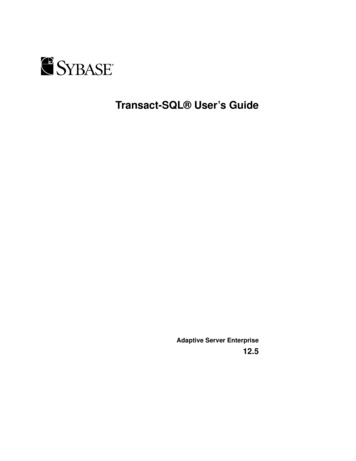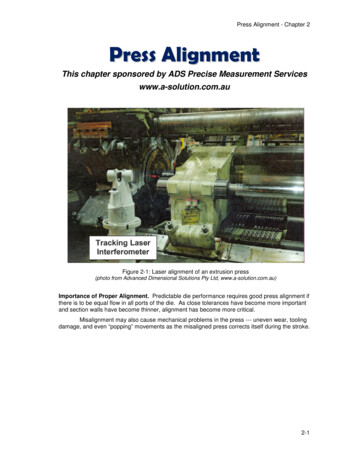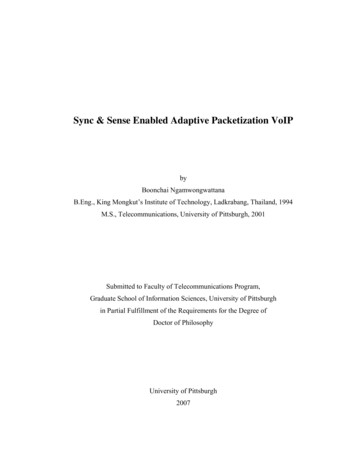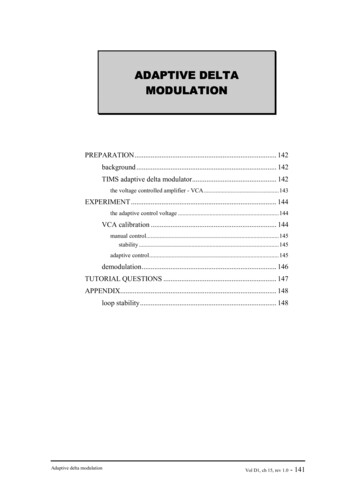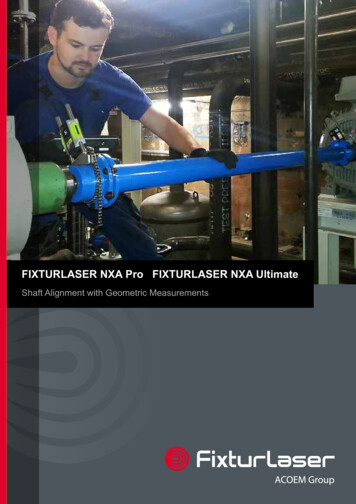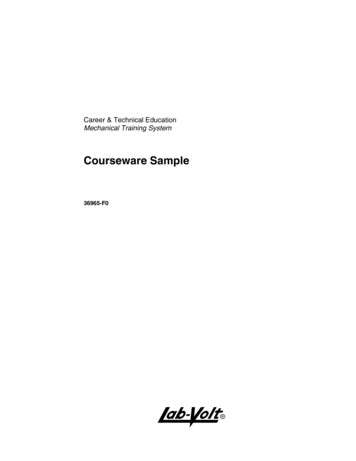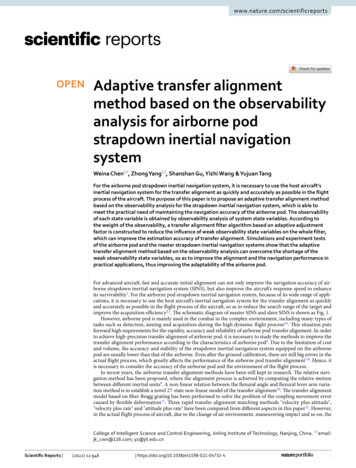
Transcription
www.nature.com/scientificreportsOPENAdaptive transfer alignmentmethod based on the observabilityanalysis for airborne podstrapdown inertial navigationsystemWeina Chen*, Zhong Yang*, Shanshan Gu, Yizhi Wang & Yujuan TangFor the airborne pod strapdown inertial navigation system, it is necessary to use the host aircraft’sinertial navigation system for the transfer alignment as quickly and accurately as possible in the flightprocess of the aircraft. The purpose of this paper is to propose an adaptive transfer alignment methodbased on the observability analysis for the strapdown inertial navigation system, which is able tomeet the practical need of maintaining the navigation accuracy of the airborne pod. The observabilityof each state variable is obtained by observability analysis of system state variables. According tothe weight of the observability, a transfer alignment filter algorithm based on adaptive adjustmentfactor is constructed to reduce the influence of weak observability state variables on the whole filter,which can improve the estimation accuracy of transfer alignment. Simulations and experiment testsof the airborne pod and the master strapdown inertial navigation systems show that the adaptivetransfer alignment method based on the observability analysis can overcome the shortage of theweak observability state variables, so as to improve the alignment and the navigation performance inpractical applications, thus improving the adaptability of the airborne pod.For advanced aircraft, fast and accurate initial alignment can not only improve the navigation accuracy of airborne strapdown inertial navigation system (SINS), but also improve the aircraft’s response speed to enhanceits survivability1. For the airborne pod strapdown inertial navigation system, because of its wide range of applications, it is necessary to use the host aircraft’s inertial navigation system for the transfer alignment as quicklyand accurately as possible in the flight process of the aircraft, so as to reduce the search range of the target andimprove the acquisition e fficiency2,3. The schematic diagram of master SINS and slave SINS is shown as Fig. 1.However, airborne pod is mainly used in the combat in the complex environment, including many types oftasks such as detection, aiming and acquisition during the high dynamic flight p rocess4,5. This situation putsforward high requirements for the rapidity, accuracy and reliability of airborne pod transfer alignment. In orderto achieve high-precision transfer alignment of airborne pod, it is necessary to study the methods to improve thetransfer alignment performance according to the characteristics of airborne p od6. Due to the limitation of costand volume, the accuracy and stability of the strapdown inertial navigation system equipped on the airbornepod are usually lower than that of the airborne. Even after the ground calibration, there are still big errors in theactual flight process, which greatly affects the performance of the airborne pod transfer alignment7,8. Hence, itis necessary to consider the accuracy of the airborne pod and the environment of the flight process.In recent years, the airborne transfer alignment methods have been still kept in research. The relative navigation method has been proposed, where the alignment process is achieved by computing the relative motionbetween different inertial units9. A non-linear relation between the flexural angle and flexural lever arm variation method is to establish a novel 27-state non-linear model of the transfer alignment10. The transfer alignmentmodel based on fiber Bragg grating has been performed to solve the problem of the coupling movement errorcaused by flexible d eformation11. Three rapid transfer alignment matching methods "velocity plus attitude","velocity plus rate" and "attitude plus rate" have been compared from different aspects in this paper12. However,in the actual flight process of aircraft, due to the change of air environment, maneuvering impact and so on, theCollege of Intelligent Science and Control Engineering, Jinling Institute of Technology, Nanjing, China. * email:jk cwn@126.com; yz@jit.edu.cnScientific Reports (2022) 12:946 123456789)
www.nature.com/scientificreports/AirplaneAirplane podLocation of themaster SINSLocation of theslave SINSFigure 1. The schematic diagram of master SINS and slave SINS.transfer alignment performance of airborne pod is uncertain. Different maneuvering modes and matching modeswill affect the observability of the system, and then affect the accuracy of transfer alignment and stability of the system13,14. Due to these reasons, there are a large number of adaptive Kalman filtering methods, such as Adaptive Extended Kalman Filter (AEKF)15, variational Bayesian based AKF (VAKF)16 and so o n17–19. However, theobservability is not considered in these methods. Introducing the state estimation with poor observability intothe system for error correction will lead to error accumulation, and may also bring coupling interference errorto other observable state parameters, resulting in the decline of filtering a ccuracy20,21. So, the general transferalignment methods may be no longer applicable due to these reasons.In this paper, an adaptive transfer alignment method based on the observability analysis for airborne podstrapdown inertial navigation system is proposed. Through the observability analysis, the observability of eachstate variable is obtained. According to the weight of the observability, a transfer alignment filter algorithm basedon adaptive adjustment factor has been constructed to reduce the influence of weak observability state variableson the whole filter, which can improve the estimation accuracy of transfer alignment. An experimental systemhas been built and different experiments have been designed to prove the effectiveness of the method.Influence of filter performance on transfer alignment performanceIn the airborne pod transfer alignment process, due to the change of air environment and maneuvering impact,there are a lot of uncertainties in the system error equation and system noise. It is difficult to establish the errormodeling. The traditional filter can’t detect and adjust automatically, so it is limited in application.On the other hand, the observability is the key problem of the alignment filter in estimating system state variables. The main task of transfer alignment is to estimate the system state variables and modify them in Strapdowninertial navigation system (SINS). When using Kalman filter to estimate the state variables, if the state variablesof the system can be observed, the estimation error standard deviation (EESD) will gradually converge and reacha stable v alue22,23. When the system is not completely observable, the EESD of the unobservable state variableswill not converge and be less than a certain boundary v alue24. In the transfer alignment, different maneuveringmodes and matching modes will lead to the problem of whether the state vector can be observed. The observability of the system determines the convergence speed and accuracy of the state estimation, and then affectsthe accuracy of transfer alignment and the stability of the system. SINS needs to update its own state accordingto the filter estimation. x̂ k represents the state estimate at k moment, and x̂ k 1 represents the state estimate atk 1 moment, x̂ represents the state estimation correction value according to the measurement information.The update equation can be expressed as:x̂ k 1 x̂ k x̂(1)If the observability of the state parameter in the transfer alignment filter is poor, that is, the matching measurement information can not directly measure the state vector. If the poor observability state estimation isintroduced into the system for error correction, it will lead to error accumulation, and may also bring couplinginterference error to other observable state parameters. Therefore, after the transfer alignment matching modeis determined, it is necessary to analyze the observability of SINS and dynamically select the state parameters toimprove the accuracy and stability of the filter.MethodAccording to the influence of uncertain noise and state observability on the transfer alignment performance ofairborne SINS, it can be seen that the performance of filter will affect the accuracy and robustness of transferalignment algorithm. Therefore, in order to further improve the accuracy and robustness of transfer alignmentfiltering, an adaptive transfer alignment filtering algorithm based on observability analysis is proposed in thissection.Observability analysis. Observability can be measured by observability degree. The observability degreecan reflect the inherent characteristics of transfer alignment model more precisely. At present, the commonlyused observability analysis methods mainly include the eigenvalue method of estimating covariance matrix andthe singular value decomposition (SVD) method of observability matrix25. The eigenvalue method for estimating the covariance matrix needs to obtain the covariance matrix of the estimated state error in the calculationScientific Reports Vol:.(1234567890)(2022) 12:946 https://doi.org/10.1038/s41598-021-04732-42
www.nature.com/scientificreports/Figure 2. The discrete measurement sequence.process, and then the observability degree can be judged. SVD is the method that the singular value and singularvector of the observability matrix are used to quantitatively describe the observability of the model. Its biggestadvantage is that it can get the analysis results of observability and observability at the same time.The specific steps of improved singular value decomposition method to analyze time-varying systems areas follows:1.2.3.4.Select the first period of the time-varying system and make j 1;Calculate the observability matrix Q for the corresponding period;Determine the current SOM matrix Q S;The measurement Z in this period is calculated according to the accuracy and size of the observation usedby the time-varying system;5. The singular value of the observability matrix Q S is calculated in the current period;6. The size of the state variable corresponding to the each singular value has been calculated. According to thesize, we can judge which state variables are observable or not;7. If the current period is not the last period, we need analyses the second period. Let j 2, return to step 2,and continue all of periods until the analysis is completed. The discrete measurement sequence is shown asFig. 2.Taking the discrete homogeneous linear system as an example, the system equation and observation equation can be expressed as:X(k 1) (k)X(k)(2)Z(k) H(k)X(k)Suppose there is a set of measurements that are Z(0), Z(1), . . . , Z(k), the initial state X(0) can be expressedas a function of the measured value:Z(0) HX(0)Z(1) H (0)X(0)Z(2) H (1) (0)X(0).(3)Z(k) H (k 1) (k 2) · · · (1) (0)X(0)Let, HZ(0)H (0) Z(1) Z(2) HF(1) (0) Q , Z . . . .H (k 1) (k 2) · · · (1) (0)X(0)Z(k) Scientific Reports (2022) 12:946 :(0123456789)
www.nature.com/scientificreports/So,(5)Z QX(0)where, Q is the observability matrix of dynamic system. The estimation of initial state X(0) depends on the characteristics of observable matrix. The singular value decomposition of the matrix Q is used to solve the problem.(6)Q USVTwhere, U [ u1 u2 · · · um ], V [ v1 v2 · · · vn ] are the orthogonal matrix, S diag( r r , 0) is the m rmatrix. Where, r r diag( σ1 σ2 . σr ) is the diagonal matrix, σ1 σ2 · · · σr 0 is the singular valueof the matrix Q. So the equation can be described as:Z (USVT )X(0) (rσi ui viT )X(0) i 1rσi (viT X(0))ui(7)i 1Obviously, the projection of the initial state X(0) on the tensor subspace is transformed into the observationZ . Therefore, the state X(0) is uniquely determined with r measurements. If σi 0(i 1, 2, . . . , r), the initialstate can be estimated and determined by using these m measurements Z . So,ruiT ZviT 1X(0) (USV ) Z (8)σii 1Let V V1 V2 , where, V1 v1 v2 · · · vl , V2 vl 1 vl 2 · · · vr . V2 represents the null space ofa matrix Q. In this case, the initial state X(0) can be expressed as:rlruiT ZviX(0) αi vi(9)σii 1i l 1where, αi (i l 1, l 2, . . . , r) is an arbitrary coefficient in the null space. It is obvious that there are manypossible solutions to this coefficient. For the singular value less than a fixed value, it may cause multiple X(0)singularities. When evaluating the influence of different vehicle maneuvering modes on the estimation accuracyof initial state X(0), the internal relationship between singular value and initial state should be studied. Whenthe observation has a constant norm, the initial state X(0) forms an ellipsoid, the equation is:2rviT X(0)ui Z 2(10)αii 1where, αi 1/σi represents the length of the main axis of the ellipsoid. Obviously, the volume of the ellipsoid isdetermined by singular value. When the singular value is large, the volume is small and X(0) is small. Therefore,the upper boundary is expressed as:X(0) Z σr(11)If σr is larger, X(0) will be small; When σr is 0, the estimation problem becomes a singular problem. Becausethe estimation is boundless, that is, X(0) cannot be determined by the measurement Z . The observability degreeis defined as the ratio of the singular value, namely:ηi σiσ0(12)where, ηi is the observability degree of the ith state26. σi is the singular value corresponding to the state. σ0 is thesingular value corresponding to the state with the measurement.Adaptive transfer alignment algorithm based on based on observability analysis. There aremany adaptive algorithms in current research, such as Sage Husa adaptive algorithm, Kalman filter algorithmwith attenuation factor. The former method has higher accuracy, but it is difficult to guarantee the stability of thesystem with higher order. The latter is simple in structure, but it reduces the filtering accuracy. In this section,Sage Husa adaptive algorithm has been adopted to improve its filtering performance. The statistical characteristics of unknown noise are obtained in real time based on the observed value Zk . The fading factor is introducedto adjust the filtering gain matrix in real time according to the observability degree of state variables.In Sage Husa adaptive algorithm, the filtering equation is shown as follows:Scientific Reports Vol:.(1234567890)(2022) 12:946 https://doi.org/10.1038/s41598-021-04732-44
www.nature.com/scientificreports/ X̂ k,k 1 X̂k 1 q̂k 1 k/k 1 Pk/k 1 k,k 1 Pk 1 Tk,k 1 Q̂k 1 1Kk Pk/k 1 HTk (Hk Pk/k 1 HTk R̂k ) ek Zk Hk X̂k/k 1 r̂k 1 X̂k X̂k/k 1 Kk ek Pk (I Kk Hk )Pk/k 1(13)The time varying noise estimator is: r̂k (1 dk )r̂k 1 dk (Zk Hk X̂k/k 1 ) R̂k (1 dk )R̂k 1 dk (ek ekT Hk Pk/k 1 HTk )(14)q̂ (1 dk )q̂k 1 dk (X̂k k,k 1 X̂k 1 ) kTTTQ̂k (1 dk )Q̂k 1 dk (Kk ek ek Kk Pk k,k 1 Pk 1 k,k 1 )where, dk (1 b) 1 bk 1 , 0 b 1. b is the forgetting factor, which can limit the memory length of thefilter. Hk is the measurement matrix. Pk/k 1 is the covariance matrix. Kk is the gain matrix. Qk is the variancematrix of system noise. Zk is the measurement. Rk is the variance matrix of measurement noise. k,k 1 is thestate transition matrix from k to k 1 moment. ek is the measurement residual of filter. qk is the mean of systemnoise and rk is the mean of measurement noise.However, this method obviously increases the calculation of the statistical characteristics of the system noise,which makes the calculation and filtering more complex. The real-time performance becomes worse, and theengineering implementation becomes more difficult. In order to improve the filtering calculation efficiency ofthe transfer alignment, it is generally considered that the system noise in the navigation system is stable. Thatis, only the measurement noise R̂k is estimated because it has a significant effect on filtering. At this time, SageHusa algorithm becomes a simplified sage Husa adaptive filtering algorithm27. This algorithm is relatively simpleand practical in engineering. Assuming r̂k 0, q̂k 0 and Qk is constant, the simplified Sage Husa filteringalgorithm is shown as follows: dk (1 b) 1 bk 1 X̂k/k 1 k,k 1 X̂k 1 PT k/k 1 k,k 1 Pk 1 k,k 1 Qk 1ek Zk Hk X̂k/k 1(15) T (H PT R̂ ) 1 K PHH kk/k 1kk/k 1kkk X̂k X̂k/k 1 Kk ekPk (I Kk Hk )Pk/k 1If the observability of a state parameter of the transfer alignment filter is poor, the introduction of the statevector with poor observability into the filter will lead to poor filtering accuracy, and may bring coupling interference error to other observable state parameters. Therefore, in order to solve the problem of the poor observability,a fading factor k is introduced into the covariance matrix of state prediction error. The fading factor can beadjusted according to the weight of observability of each state variable, so as to adjust the filter gain matrix Kk.k is the time-varying fading factor matrix. It is defined as follows: 1 0 · · · 0 0 2 · · · 0 k . . (16) . . 0 0 · · · nwhere, n is the dimension of the state quantity, ik (i 1, 2, . . . , n) is the fading factor corresponding to each state.The fading factor can be calculated by the following steps:Step 1: Set the initial value ik , 11 1;Step 2: Get the geometric mean γ of the observability ηi. Geometric mean (GM) is the n-th root of the productof observations, which is used to calculate ratio or dynamic mean.Step 3: The adaptive factor k is obtained according to the geometric average of the second step.(i, i)k 1 1nηi /γ (i, i)k , (i 1, 2, ., n)(17)Because the adaptive factor is directly related to the observability, the larger observability is, the larger theweight is. The fading factor is introduced to adjust the gain matrix Kk on-line in real time so that it is related tothe observability, and the prediction covariance matrix is calculated according to k.Pk 1/k k 1 k 1/k Pk/k T k 1/k Tk Qk 1 TT k(18)Tk is the system noise driving matrix. According to the above equation, the gain matrix of the system isobtained as follows:Scientific Reports (2022) 12:946 123456789)
www.nature.com/scientificreports/ 1Kk 1 Pk 1/k HT k 1 Hk 1 Pk 1/k HT k 1 Rk 1(19)It can be seen from above equations that method of the adaptive filtering based on observability introducesfading factor k, which plays an important role in the calculation of one-step prediction covariance matrix. Whenthe observability of the system state changes, it increases accordingly, and the state error with large observability is enhanced. At the same time, the filter can estimate and modify the statistical rules and characteristics ofmeasurement noise online, so as to reduce the error of state estimation and improve the alignment accuracyand rapidity of the system.Establishment of transfer alignment modelBecause the delay of the reference navigation information has a great influence on velocity and attitude, thevelocity/attitude matching method is selected for alignment, and the time delay is estimated and compensated.The statesub INS misalignment angle φ n [ φE φN φU ]T , velocity errorT alignment include bsvariables of transfernδV δVE δVN δVU , acceleration bias [ xbs ybs zbs ]T , gyro drift εbs [ εxbs εybs εzbs ]T , installation error angle µ [ µx µy µz ]T and delay time t . Namely:T(20)X(t) φ n δVn εbs bs µ tThe state error equation of strapdown inertial navigation system is as follows: n φ n δωn C n ε bs φ̇ n ωinin bs nnn ) v n (2ωn ωn ) δv n C n bsδ ν̇ f φ n (2δωien δωeneniebsbsbs ε̇ 0, 0 µ̇ 0(21)n is the angular velocity of the navigation system relative to the inertial system obtained by the sub inerwhere, ωinn is the error of angular velocity ωn ; C n is the attitude matrix of the sub ins carriertial navigation system, and δωinin bssystem relative to the navigation system; f n is the projection of the specific force of the sub ins in the navigationnsystem; ωie is the projection of the earth rotation rate measured by the sub INS on the navigation system, and δωienn is the projection of the angular rate of the navigation coordinate relativeis the error of angular velocity ωien ; ωenn is the error of angular velocity ωn .to the earth coordinate in the navigation coordinate, and δωenenThe delay time Δt in the transfer alignment is usually treated as a random constant. So the model of the delaytime t is as follows:(22)ṫ 0For the velocity/attitude matching mode, the observation Z(t) in the alignment filter is chosen as the velocityand attitude difference between the main and sub INS. The velocity measurement Zvelo is shown as: V̇EvelonnnZ Vs Vm δV V̇N t(23)V̇Uatti:The attitude measurement Zatti is acquired by using Zbsattin bs bmZbs ĈbsĈbm Cn(24)where, Cnbm is the direction cosine matrix from the reference inertial navigation coordinate system to the navibs is the direction cosine matrix from reference inertial coordinate system to subgation coordinate system. Ĉbmn is the direction cosine matrix from the subinertial coordinate system, which contains calculation error. Ĉbsinertial navigation carrier coordinate system to the navigation coordinate system, which also contains the calculation error.Ĉnbs [I (φ )]Cnbs Cnbs (φ )Cnbs(25)bs [I (µ )]Cbs Cbs (µ )CbsĈbmbmbmbmwhere, φ is the attitude misalignment angle between the calculated navigation coordinate system and the realnavigation coordinate system of the sub INS. µ is the installation error angle from the reference inertial navigation coordinate system to the sub inertial navigation coordinate system. Both of them are small angles.attin bs bmĈbm CnZbs Ĉbs [Cnbs (φ )Cnbs ][Cnbs (µ )Cnbs ] In (φ ) Cbs(µ )Cnbs(26)n (φ )Cbs(µ )CnbsTaking into account that φ and µ are small angles, the above equation can be simplified as:attinnZbs I (φ ) Cbs(µ )Cnbs I (φ ) [(Cbsµ) ](27)The velocity measurement Zatti is shown as:Scientific Reports Vol:.(1234567890)(2022) 12:946 https://doi.org/10.1038/s41598-021-04732-46
ate variablesVNxyzxyState variables(a) Uniform linear motion(b) Accelerating straight line 0xyzVEVN0xyzxyxState variablesyzVEVNxyzxyState variables(c) Uniform turning motion(d) Accelerate turning motionFigure 3. Comparison of state observability degree under 4 different maneuvering modes.Zatti atti (2, 3)φ̇xZbsatti (3, 1) φ Cn µ v φ̇ t Zbsφybsatti (1, 2)Zbsφ̇z (28)where, vφ is the attitude measurement noise.Simulation and experiment resultsIn this section, simulations and experiments have been accomplished to verify and evaluate the performance ofthe proposed method. Firstly, the observability of the system under different maneuvering modes is analyzed.Secondly, the simulation performance of the adaptive transfer alignment algorithm based on observability hasbeen compared with that of the traditional transfer alignment algorithm. Thirdly, a vehicle experiment has beenverified the proposed method is superior to the traditional method in the practical use.Simulation analysis. In order to verify the estimation effect of the adaptive transfer alignment algorithmbased on observability analysis, the transfer alignment of airborne SINS is simulated in this section.(1) The observability of the system under different maneuvering modes is analyzed.The transfer alignment is simulated in velocity matching mode. The simulated flight path includes 4 differentmaneuvering modes: uniform linear motion, accelerated linear motion, uniform turning motion and acceleratedturning motion. The method based on singular value decomposition is used to analyze the observability of statevariables. Figure 3 compares the observability degree of the state variables under 4 different maneuvering modes.Scientific Reports (2022) 12:946 123456789)
www.nature.com/scientificreports/SensorReference inertial navigation systemAirborne pod inertial navigation systemError sourcesParameters valueRelevant timeGyroscope constant drift0.1 /h0Gyroscope first order Markov process drift0.1 /h3600 sGyroscope white noise measurement0.1 /h0Accelerometer constant bias1 10-4 g0Accelerometer first order Markov process1 10-4 g1800sGyroscope constant drift10 /h0Gyroscope first order Markov process drift10 /h3600 sGyroscope white noise measurement10 /h0Accelerometer constant bias3 10-4 g0Accelerometer first order Markov process3 10-4 g1800sTable 1. Parameters of navigation sensors.It can be seen from Fig. 3 that since the velocity information is used as the measurement for matching, theobservability of velocity variable is constant and it is defined as 1 according to the definition of observability. Inaddition, the observability of other state variables is different under the 4 maneuvering modes. In the uniformlinear motion, z-axis misalignment angle φz and z-axis gyroscope drift ϵz are not observable, but the observability increases significantly after changing to acceleration or turning maneuver.(2) The performance of the proposed method is compared with the traditional method.The simulation conditions are set as follows: the initial longitude, latitude and altitude of the designed aircraftare 118 , 32 and 1500 m respectively, the initial attitude errors are 0.2 , 0.1 and 0.1 respectively, the total timeis 300 s. The settings of the reference inertial navigation system and the airborne pod inertial navigation systemare shown in Table 1.The duration of the simulated flight path is 300 s. The aircraft accelerates at 3 m/s2 at the initial speed of200 m/s in the first 30 s before sailing, and then flies in a straight line at a constant speed. The proposed AKFmethod is used for simulation verification, and KF, VAKF, AEKF algorithms mentioned in the introduction areused for comparison. Figure 4 shows the estimation results of different algorithms. The dotted line representsthe proposed method, and the solid line represents the traditional transfer alignment method.It can be seen from the figure that in the 300 s of the transfer alignment process, the proposed method hasimproved the estimation accuracy of misalignment angle compared with the traditional algorithm. The estimation accuracy of horizontal misalignment angle is improved by 0.5 arc minutes and azimuth misalignment angleis improved by 2 arc minutes. In terms of the convergence rate of the estimation curve, the proposed methodcan also quickly converge to the steady state. This is because the observability of the state variables is consideredin the proposed algorithm. For the state variables with weak observability, the adaptive filtering algorithm canadjust the weight by fading adaptive factor, and maintain good state estimation ability, so as to improve theaccuracy and rapidity of transfer alignment.(3) When the noise of the sensor measurement is abnormal, the performance proposed method is comparedwith the traditional transfer alignment method.In order to verify the adaptability of the proposed method, the simulation sets the measurement noise changeduring 100 200 s. Because the speed matching is used as the measurement information in this section, thestandard deviation of speed measurement can be set from 0.1 to 1 m/s. Figure 5 shows the error angle estimationresults of four different algorithms with abnormal noise measurement.From Fig. 5, it can be seen that when the speed measurement noise is set in the period of 100 200 s, the measurement characteristics of the system will change, and the traditional algorithm can not change the parametersto adapt to the change of the noise measurement, resulting in the rapid deterioration of the transfer alignmentaccuracy; However, because the proposed algorithm can estimate and correct the measurement noise onlineby using the time-varying noise estimator. As a result, the adaptive transfer alignment algorithm still has goodaccuracy, so as to improve the accuracy and rapidity of transfer alignment.Ground experiment and discussion. To further verify the method proposed in the paper, the vehicleexperiment platform has been constructed, as shown in Fig. 6a. We can see the connection diagram of on-boardexperimental devices from Fig. 6b. The performance of the algorithm has been analyzed and verified. The testplatform contain Kalman’ the reference navigation system and the airborne pod navigation system (SINS). Thereference navigation system can provide the reference information for the alignment. The equivalent gyroscopedrift of the master INS is 0.5 /h, and the equivalent accelerometer bias is 100 μg. The gyroscope constant andrandom drift of sub INS is 5 /h, while accelerometer constant and random bias is 300 μg. The Rauch-TungStriebel post-processing smoothing algorithm is adopted to acquire the reference navigation solutions, which isoften used to assess the performance of the alignment.The experiment was carried out in Henan Luoyang, the position of which is 112 3′ E, 34 3′ N. The alignmentdata of 300 s has been selected for verification. Figure 6c shows the trajectory of field test, where the start andend points are indicated. We select two segments of experiment data to verify the performance. Figure 7 andTable 2 show the alignment results with different methods in the accelerated linear motion.Figure 8 and Table 3 show the alignment results with different methods in th
borne strapdown inertial navigation system (SINS), but also improve the aircra 's response speed to enhance ts i yt urvasli vi bi 1. For the airborne pod strapdown inertial navigation system, because of its wide range of appli-cations, it is necessary to use the host aircra 's inertial navigation system for the transfer alignment as quickly
